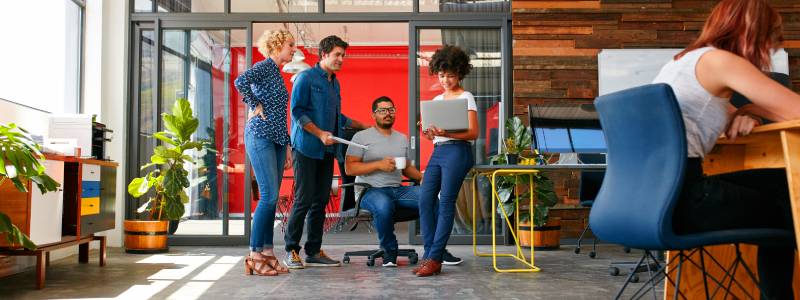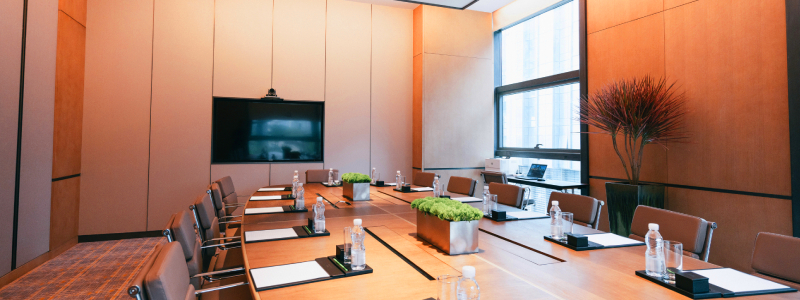As soon as your business starts to grow you need more office space. Fullstack gives you the nine key tips you need to find the right place.
Whether you’re running a small to medium startup, or an established business looking to scale, finding the right office space can be daunting task, even if it’s not your first time.
With the latest figures reflecting a steady dip in office vacancy rates in major Australian cities, it’s likely to become increasingly difficult to choose a workspace that can cater to all your business needs.
There are a plethora of factors to consider, such as running costs, usable space, location, amenities, lease duration… the list goes on.
We’ve put together a list of tips to help make your life easier the next time you’re out hunting for a new office space. These are some of the most important decisions you need to make to find the office space of your dreams.
1. Workplace Location
As the old saying goes “Location, location, location”.
Location may not be your number one concern, but it should be right up there on your lists of top priorities in choosing your next office space.
An ideal office should be conveniently located not just for your team, but for your clients too.
Getting to and around your new office shouldn’t be a daily hassle. Pick an office that is closely situated to metro or bus stations, dining places, cafes and other common amenities.
If your team are mostly car drivers or cyclists, ensure there are ample spaces for them to park their rides.
Take the time to go out there and explore the office’s vicinity. Take a short walk or drive around yourself.
See if the location fits the ideal image you wish to portray for your business, and weigh in the real-life practicalities of your daily business life.
2. Design
Speaking of image, both the interior and exterior design of your new office can play a significant role in projecting the ideal reputation for your business.
A modern and well-designed office can create an impactful image on your employees and shareholders, but they also tend to come with a bigger price tag.
Be sure to balance visual appeal with functionality. Visual aesthetics become more of a priority in a face-to-face sales based environment whereas functional environments favour a more back-office operation.
At the end of the day, your office is a place where you do business; where your employees will be spending majority of their waking hours inside, week after week. So make sure that the office design is conducive to the comfort of its dwellers too, especially if you are planning to move into a fully fitted out office.
3. Fitted vs Unfurnished
Fitted offices are usually fully furnished with all the office furniture that a typical business requires, such as desks, chairs, workstations, reception areas and meeting rooms.
They also come with complete heating and ventilation, telephone and Wi-Fi networks already installed.
All that is left is for you to move your business operations in and get started with little to no downtime.
An unfurnished office is the opposite. You are getting a blank canvas.
While some unfurnished offices do come ready with standard electrical, plumbing and air-conditioning amenities, and you will be required to carry out the rest of the interior work.
There are pros and cons to both options. If you are leasing a fitted office, you can expect to pay more per month compared to an unfurnished one.
On the other hand, an unfurnished office allows you to design the space according to your desired corporate image.
Want a reception counter made from a piece of 7m eucalyptus tree log? You can do that easily with an unfurnished office, while with a fitted office you’ll likely need to seek permission from the owner.
Choosing a fitted or unfurnished office can make a difference between the long term costs, aesthetics and functionality of your workspace. You’ll need to weigh your options and see which one will deliver the most benefits.
For most cases, choosing a fitted office is usually the more cost-effective choice for businesses with less than 20 employees, since the smaller headcount can easily offset the higher costs.
4. Room for Expansion
While it can be hard to gauge just how much room you will take up as your business scales, looking for an office that has room to grow can save bring you significant time and financial savings.
With enough room for growth, you won’t need to relocate to another office due to the shortage of space.
The key here is to be flexible with not just your office space, but with your lease as well if you are renting.
Try to negotiate for a shorter lease with the property owner, or a get one that lets you exit early if the need arises.
5. Shared facilities & coworking spaces
If you’re still unsure if a small office space is right for you, then perhaps you should consider looking for a building that offers shared facilities onsite & coworking.
Having access to shared facilities such as meeting rooms, printers, supply cabinets, toilets and pantries can save you some money since you won’t need the space for these amenities within your office.
Of course, if your business deals with confidential clients or large amounts of sensitive data projects, this option might be less appealing in terms of security.
Otherwise, most modern shared facilities are usually state-of-the-art. Some buildings even offer shared receptions that will handle your visitors on your behalf.
6. Operating Costs
Operating expenses consists of costs that you or your landlord will incur during the operation, repair or maintenance of the office property.
These can include land tax, water rates, council rates, security staff, cleaning of common walkway areas, and other maintenance costs.
Before you enter into any contract, make sure you are fully aware of all the operating costs that you will need to pay, as they can considerably add to your operation costs.
Do note that costs such as structural repairs and capital items should also be classified under the owner’s expense since he enjoys the ongoing value of these items.
7. Wellness facilities
Caring for the physical and emotional well-being of your workforce should be part of your consideration when choosing a new office space.
Having access to wellness facilities for employees keeps them motivated. They can let their hair down to recharge, or to have a good workout after a long day at work.
Look for an office building that offers gym facilities or other wellness amenities.
Many commercial buildings will offer group exercise classes for activities such as boxing, yoga or Pilates at no cost, which offers major benefits for your employees.
8. Building Management
Now that you are close to getting your new office space, your property manager will become your key contact person with the landlord, and his or her capabilities shouldn’t be ignored.
Talk to other building tenants before signing your lease to learn about the management quality of the building’s security, engineering and janitorial services.
Use the feedback from current tenants to gauge the performance level of your property manager and their involvement towards property related matters.
- This is also a good opportunity to learn about the frequency of disruptions that can occur to tenants, such as:
- Heating, ventilation and air cooling system issues (is the temperature always too warm or too cold)
- Level of cleanliness that the cleaning staff is performing
- Whether there are any frequent breakdowns of the lifts and elevators
- Parking space situations
- The tenancy mix & background noise
There’s nothing worse than picking a wrong office building without taking into the account of the existing tenants.
There are occasions where existing tenants may butt heads with new tenants because they perceive the newcomer as a significant competitor in the same building.
On the flip side, an attractive tenant mix can position the office building as a go-to place for clients seeking relevant services. For example, you can usually find accounting firms in the same building as law firms because both types of businesses tend to support each other.
Also, take note of the image of the current tenants as well. The corporate image they portray can help complement your own business simply by proximity, and help give your corporate branding efforts a boost.
9. Landlord Relationship
When you plan to enter a long lease, you’ll want to be sure that you’re going to have a great future working relationship with your landlord.
The best office spaces landlords know that their tenants’ business success is just as important as the tenants themselves.
Make sure that both you and your building’s landlord are on the same page, and both parties are in agreement on all lease-related matters before you begin your tenancy.
Once you start on the right foot, you are more likely to negotiate a more favourable deal should you choose to renew your lease next time.
Bonus Tip: Don’t be rushing into things
When you’re looking for a new office space, keep in mind that time is your best asset.
Take as much time as you need to evaluate your office options properly. If you ever feel that you’re getting pressured to close the deal quickly, be prepared to walk away.
Choosing an office workspace is always a major decision for your business.
It’s a move that will make an impact on nearly every aspect of your business, from investor relations, employee productivity to your clients’ first impression.
Making the wrong decision can affect your ability to attract or even retain the right clients, costing you additional business opportunities and finances.
So make sure you carry out your proper due diligence, do your homework and find yourself the perfect office workspace.
Was this article helpful?
Related Posts
- Preference Shares
Preference Shares are a separate class of share and have features which can be used…
- Hot tax return tips for founders
We look after the entire tax and accounting situation for hundreds of founders. Do you…
- Information Memorandum - A Guide
An Information Memorandum (or Investment Memorandum, “IM”) is the most commonly used disclosure document to…
- Slicing the Pie – How ESS and ESOP arrangements work
The performance of your team can make or break your chances of success. Incentive better…

















